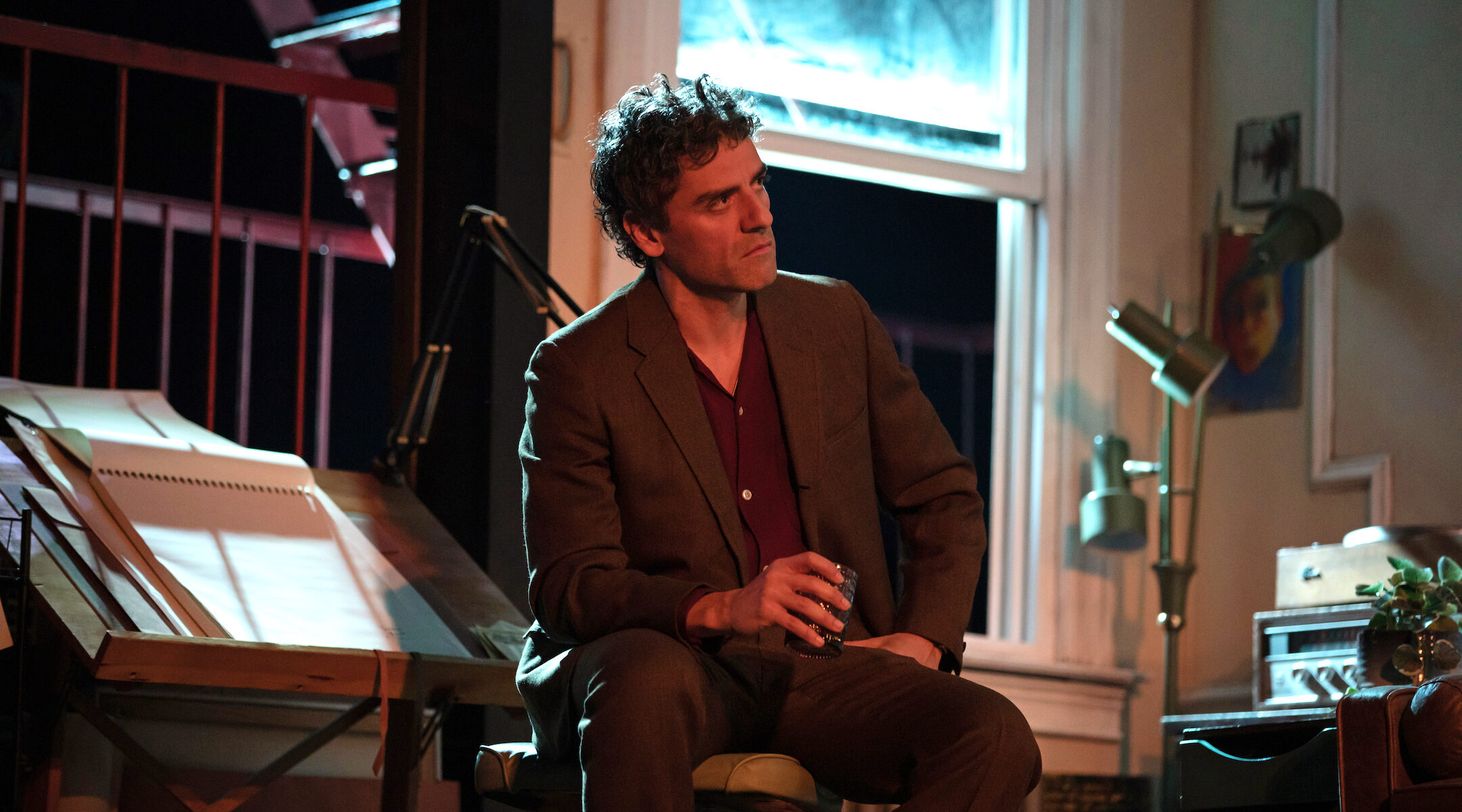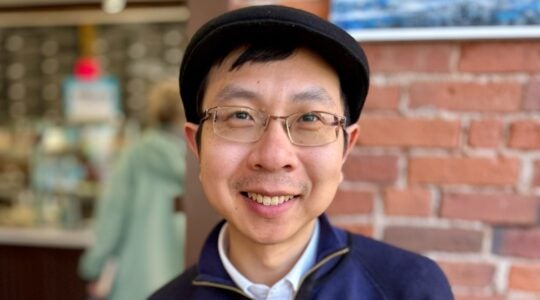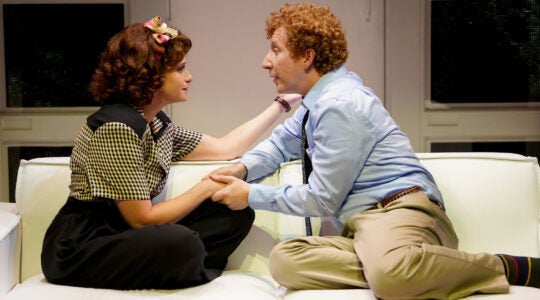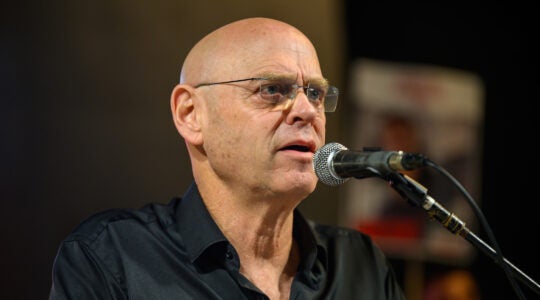NEW YORK (JTA) — Sidney Brustein, Jewish Hamlet?
Anne Kauffman thinks so. She made the comparison in a phone interview about the play she’s directing — a buzzy production of Lorraine Hansberry’s “The Sign in Sidney Brustein’s Window” that opened on Monday at the Brooklyn Academy of Music starring Oscar Isaac and Rachel Brosnahan.
“One artistic director who was thinking of doing this [play] was like, ‘You know, it’s not like he’s Hamlet, but…’ And I thought, well, no, actually I think he is like Hamlet!” she said.
She added another take: “I feel like he’s Cary Grant meets Zero Mostel.”
Hansberry saw just two of her works produced on Broadway before her death from cancer at 34 in January 1965. Her first, “A Raisin in the Sun,” which follows a Black family dealing with housing discrimination in Chicago, is widely considered one of the most significant plays of the 20th century. The other, “The Sign in Sidney Brustein’s Window,” ran for a few months in the fall of 1964 until Hansberry’s death and has only been revived a handful of times since, all outside of New York.
Now, the star power of Isaac and Brosnahan is driving renewed interest in the play, which deals with weighty questions about political activism, self-fulfillment in a capitalist world, and racial and ethnic identity — including mid-century Jewish American identity.
The Brustein character, as Kauffman alluded to, is many things. A resident of Greenwich Village deeply embedded in that historic neighborhood’s 1960s activist and artistic circles, he is somewhat of a creative renaissance man. At the start of the play, his club of sorts (“it was not a nightclub” is a running joke) called “Walden Pond” has just shuttered and he has taken over an alternative newspaper. As the script reads, Brustein is an intellectual “in the truest sense of the word” but “does not wear glasses” — the latter description being a possible jab at his macho tendencies. Formerly an ardent leftist activist, he is now weary of the worth of activism and a bit of a nihilist. He’s in his late 30s and is a musician who often picks up a banjo.
Brustein is also a secular Jew, a fact that he telegraphs at certain key emotional and comedic moments. Others, from friends to his casually antisemitic sister-in-law, frequently reference his identity, too.
At the end of the play’s first half, for example, Brustein brings up the heroes of the Hanukkah story in talking about his existential angst — and his stomach ulcer. He has become belligerent to his wife Iris and to a local politician who wants Brustein’s paper’s endorsement.
“How does one confront the thousand nameless faceless vapors that are the evil of our time? Can a sword pierce it?” Sidney says. “One does not smite evil anymore: one holds one’s gut, thus — and takes a pill. Oh, but to take up the sword of the Maccabees again!”
Hansberry’s decision to center a white Jewish character surprised critics and fans alike in 1964 because many of them expected her to follow “A Raisin in the Sun” with further exploration of issues facing Black Americans, said Joi Gresham, the director of the Lorraine Hansberry Literary Trust.
“The major attack, both critically and on a popular basis, in regards to the play and to its central character was that Lorraine was out of her lane,” Gresham said. “That not only did she not know what she’s talking about, but that she had the nerve to even examine that subject matter.”
Hansberry’s closest collaborator was her former husband Robert Nemiroff, a Jewish New Yorker whom she had divorced in 1962 but maintained an artistic partnership with. Nemiroff was a bit Brustein-like in his pursuits: he edited books, produced and promoted Hansberry’s work, and even wrote songs (one of which made the couple enough money to allow Hansberry to focus on writing “A Raisin in the Sun”). But Gresham — who is Nemiroff’s stepdaughter through his second marriage, to professor Jewell Handy Gresham-Nemiroff — emphasized that his personality was nothing like Brustein’s. While Brustein is brash and mean to Iris, Nemiroff was undyingly supportive of Hansberry and her work, said Gresham, who lived with him and her mother at Nemiroff’s Croton-on-Hudson home — the one he had formerly shared for a time with Hansberry — from age 10 onward.
Instead, Gresham argued, the Brustein character was the result of Hansberry’s deep engagement with Jewish intellectual thought, in part influenced by her relationship with Nemiroff. The pair met at a protest and would bond over their passion for fighting for social justice, which included combating antisemitism. The night before their wedding, they protested the executions of Julius and Ethel Rosenberg, and they would remain highly involved in the wave of activism that blossomed into the Black-Jewish civil rights alliance.
“Bob and Lorraine met and built a life together at a place where there was a very strong Black-Jewish nexus. There was a very strong interplay and interaction,” Gresham said. “I think Lorraine was very influenced by Bob’s family, the Nemiroffs, who were very radical in their politics. And so there was a way in which she was introduced to the base of Jewish intellectualism and Jewish progressive politics, that she took to heart and she was very passionate about.”
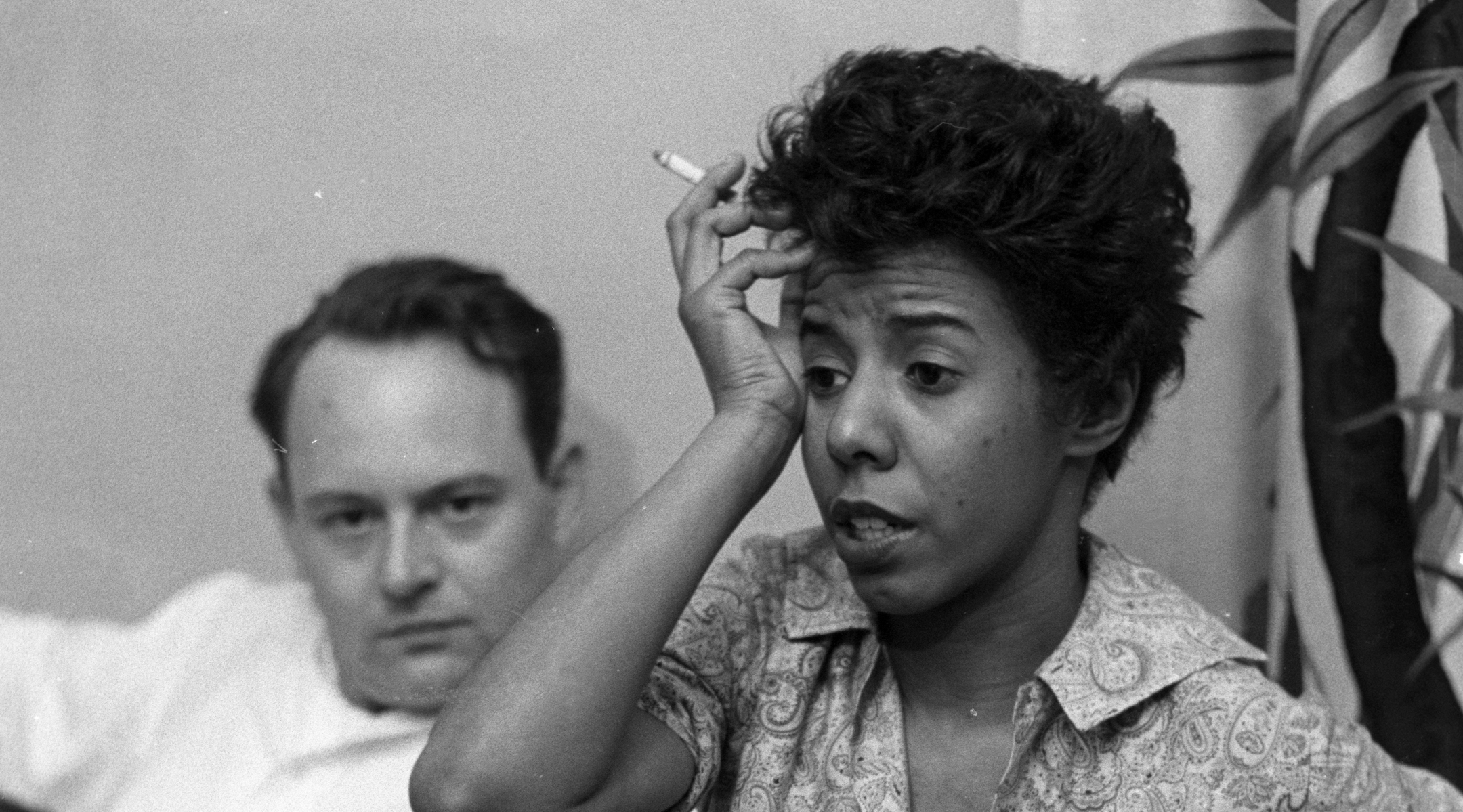
Robert Nemiroff and Lorraine Hansberry were married from 1953-62. They are shown here in 1959. (Ben Martin/Getty Images)
Hansberry didn’t hesitate to criticize Jewish writers who said controversial things about Black Americans, either. When Norman Podhoretz wrote “My Negro Problem — And Ours,” an explosive 1963 article in Commentary magazine now widely seen as racist, Hansberry responded with a scathing rebuke. She also sparred with Norman Mailer, who once wrote an essay titled “The White Negro: Superficial Reflections on the Hipster.”
Gresham said Brustein’s nihilism represents what Hansberry saw in a range of Jewish and non-Jewish white writers, whom she hoped could be kickstarted back into activism. But Hansberry also nodded to the reasons why someone like Brustein could feel defeated in the early 1960s, a decade and a half after World War II.
“You mean diddle around with the little things since we can’t do anything about the big ones? Forget about the Holocaust and worry about — reforms in the traffic court or something?” Brustein says at one point in the play to a local politician running as a reformer.
Daniel Pollack-Pelzner, a Jewish scholar of literature who has written on Hansberry, said the resulting Brustein character is a very accurate depiction of a secular Jew at the time — both keenly attuned to prejudice in society and also lacking some understanding of the experience of being Black.
“I was just intoxicated that Hansberry could conjure that world, both so affectionately, but also so clear-sidedly that it seems like she can see the limitations of all of the characters’ perspectives,” he said. “But she also represents them with sympathy and humor.”
Kauffman, who also helmed a revival of the play in Chicago in 2016, is impressed with how “fully fledged” the Brustein character is.
“Who are the cultural icons who have sort of articulated the Jew in our culture in the last 50 years or 60 years, you know?” she said. “Brustein is not a caricature of a Woody Allen character, he’s not even ‘Curb your Enthusiasm’ or a Jerry Seinfeld character. He’s a fully drawn character.”
Isaac, who is of mainly Guatemalan and Cuban heritage, has played Jewish characters before, including a formerly Orthodox man in an Israeli director’s remake of the classic film “Scenes From a Marriage.” In the lead-up to this play, he has largely avoided getting caught in headlines focused on the “Jewface” debate, over whether non-Jewish actors should be allowed to play Jewish characters on stage and screen.
But when asked about the responsibility of playing a Jewish character in a New York Times interview, Isaac referenced the fact that he has some Jewish heritage on his father’s side.
“We could play that game: How Jewish are you?” he said to interviewer Alexis Soloski, who is Jewish. “It is part of my family, part of my life. I feel the responsibility to not feel like a phony. That’s the responsibility, to feel like I can say these things, do these things and feel like I’m doing it honestly and truthfully.”
When Kauffman directed a version of the play at the Goodman Theater in Chicago in 2016, her lead actor had “not a single drop of Jewish heritage…in his blood,” and she said she had to convey “what anger looks like” coming from a Jewish perspective. Working with Isaac has been different — instead of starting at a base of no knowledge, she has been pushing for more of an Ashkenazi sensibility than a Sephardic one.
“I believe that his heritage leans, I’m guessing, more towards Sephardic. And mine is pure Ashkenazi,” she said. “We sort of joke: ‘[The part] is a little bit more Ashkenazi than that, you know what I mean?’ Like, ‘the violence is actually turned towards yourself!’”
JTA has documented Jewish history in real-time for over a century. Keep our journalism strong by joining us in supporting independent, award-winning reporting.
